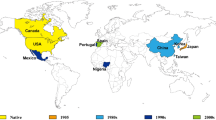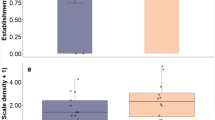Abstract.
Phytoseiid mites were sampled in a grapefruit orchard at various times of the day to study their diurnal and seasonal distributions in the tree canopy. Samples were collected on 14, 20 and 28 October 1999 at 2 h intervals from 0600 to 2200 h. Similar samples were collected in a grapefruit orchard at 3 h intervals from 0600 to 2100 h on 9 and 16 March and on 17 and 24 August 2000 for phytoseiid mites. No differences in numbers of phytoseiid motiles were observed among the hours sampled in any of the three months. However, significant differences were observed in the number of phytoseiids per leaf based on location within the tree (eastern, western sides of the canopy or interior). Interior leaves collected in March and August 2000 had higher numbers of phytoseiids than exterior leaves taken from either the eastern or western sides of the tree canopy. Phytoseiids were more abundant in the March 2000 samples (mean = 1.10 phytoseiids/leaf) than in either October 1999 or August 2000 samples (mean = 0.16 and 0.19 phytoseiids/leaf, respectively). Prevalent phytoseiid species were Typhlodromalus peregrinus (Muma) (42.1%) and Iphiseiodes quadripilis (Banks) (50.4%) in October 1999, Typhlodromalus peregrinus (Muma) (76.2%) in March 2000, and Euseius mesembrinus (Dean) (54%) in August 2000.
Similar content being viewed by others
References
M.M. Abou-Setta C.C. Childers (1987) ArticleTitleBiology of Euseius mesembrinus (Acari: Phytoseiidae): life tables on ice plant pollen at different temperatures with notes on behaviour and food range Exp. Appl. Acarol. 3 123–130
J.C. Allen C.W. McCoy (1979) ArticleTitleThe thermal environment of the citrus rust mite Agric. Meteorol. 20 411–425
J.C. Allen J.P. Syvertsen (1981) ArticleTitleThe world of the citrus rust mite: a microclimate prediction problem Proc. IX Int. Congr. Plant Prot. 1 138–140
D.A. Chant (1985) Sytematics and Morphology W. Helle M.W. Sabelis (Eds) Spider Mites, their Biology, Natural Enemies and Control. Vol. 1B Elsevier Amsterdam 103–129
C.C. Childers (1994) Biological control of phytophagous mites on Florida citrus utilizing predatory arthropods D. Rosen F.D. Bennet J.L. Capinera (Eds) Pest Management in the Subtropics Intercept Andover U.K 255–288
C.C. Childers H. Aguilar R.T. Villanueva M.M. Abou Setta (2001) ArticleTitleComparative toxicities of pesticides to the predator Euseius mesembrinus (Acari: Phytoseiidae) on citrus in Florida Fla. Entomol. 84 391–401
D.N. Ferro R.B. Chapman R. Penman (1979) ArticleTitleObservations on insect microclimate and insect pest management Environ. Entomol. 8 1000–1003
G.S. Fraenkel D.L. Gunn (1961) The orientation of animals kineses, taxas and compass reactions Dover Publ. Dover 376
F. Garcia-Mari R. Laborda J. Costa-Comelles F. Ferragut C. Marzal (1985) ArticleTitleAcaros fitofagos y depredadores en nuestros citricos Cuadernos de Fitopatologia 2 54–63
D.M. Gates (1968) ArticleTitleTranspiration and leaf temperature Annu. Rev. Plant Physiol. 19 211–238
G.W. Krantz (1978) A manual of acarology. 2nd ed Oregon State Univ. Book Stores, Inc. Corvallis, Oregon 509
T.A. Martin T.M. Hinckley F.C. Meinzer D.G. Sprugel (1999) ArticleTitleBoundary layer conductanceleaf temperature and transpiration of Abies amabilis branches Tree Physiol. 19 435–443
M.H. Muma (1964) ArticleTitleThe population of Phytoseiidae on Florida citrus Florida Entomol. 47 5–11
Muma M.H. 1967. Typhlodromalus peregrinus (Muma) (Acarina: Phytoseiidae) on Florida citrus. Proc. 2nd Int. Congr. Acarol. Budapest Publishing House of the Hungarian Acad. Sci. AkademiaKiadopp. 135–148.
M.H. Muma (1975) Mites associated with citrus in Florida Agric. Exp. Sta IFAS, Univ. Florida Gainesville. Bull. 640A. 92
M.M. Muma H.A. Denmark (1971) Phytoseiidae of Florida. Arthropods of Florida and neighboring land areas. Vol. 6 Florida Dept. Agric. Cons. Serv. Florida 150
M.M. Muma A.G. Selhime (1971) ArticleTitleAgistemus floridanus (Acarina: Stigmaeidae) a predatory mite on Florida citrus Fla. Entomol. 54 249–258
A.P. Norton G. English-Loeb E. Belden (2001) ArticleTitleHost plant manipulation of natural enemies: leaf domatia protect beneficial mites from insect predators Oecologia 126 535–542
D.J. O’ Dowd M.F. Willson (1997) ArticleTitleLeaf domatia and the distribution and abundance of foliar mites in broadleaf deciduous forest in Wisconsin Am. Midl. Nat. 137 337–348
A. Onzo R. Hanna I. Zannou M.W. Sabelis J.S. Yaninek (2003) ArticleTitleDynamics of refuge use: diurnal, vertical migration by predatory and herbivorous mites within cassava plants Oikos. 101 59–69
J. Pena (1992) ArticleTitlePredator-prey interactions between Typhlodromalus peregrinusPolyphagotarsonemus latus: effects of alternative prey and other food resources Fla. Entomol. 75 241–248
J. Pena R.M. Baranowski H.A Denmark (1989) ArticleTitleSurvey of predators of the broad mite in Southern Florida Fla. Entomol. 72 373–377
A. Roda J. Nyrop M. Dicke G. English-Loeb (2000) ArticleTitleTrichomes and spider-mite webbing protect predatory mite eggs from intraguild predation Oecologia 125 428–435
M.W. Sabelis (1985) Predation on spider mites W. Helle M.W. Sabelis (Eds) Spider Mites, their Biology, Natural Enemies and Control. Vol. 1B Elsevier Amsterdam 103–129
InstitutionalAuthorNameStatsoftInc. (2000) Statistica for Windows Tulsa OklahomaUSA
R.T. Villanueva (2002) A study of the biology and ecology of selected predators of phytophagous mites on Florida citrus Doctoral dissertation Univ. Florida Gainesville
D.E. Walter (1996) ArticleTitleLiving on leaves: mites, tomentaand leaf domatia Annu. Rev. Entomol. 41 101–114
T.A. Wheaton W.S. Castle D.P.H. Tucker J.D. Whitney (1978) ArticleTitleHigher density plantings for Florida citrus Proc. Fla. State Hort. Soc. 91 36–40
Author information
Authors and Affiliations
Corresponding author
Rights and permissions
About this article
Cite this article
Villanueva, R., Childers, C. Diurnal and spatial patterns of Phytoseiidae in the citrus canopy. Exp Appl Acarol 35, 269–280 (2005). https://doi.org/10.1007/s10493-004-5728-4
Received:
Accepted:
Issue Date:
DOI: https://doi.org/10.1007/s10493-004-5728-4




